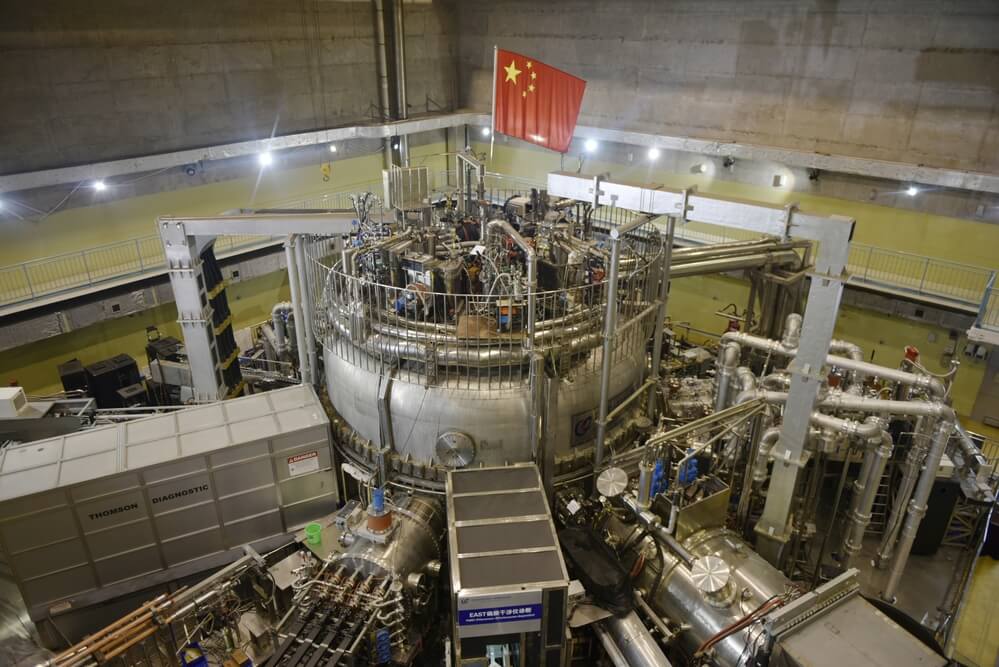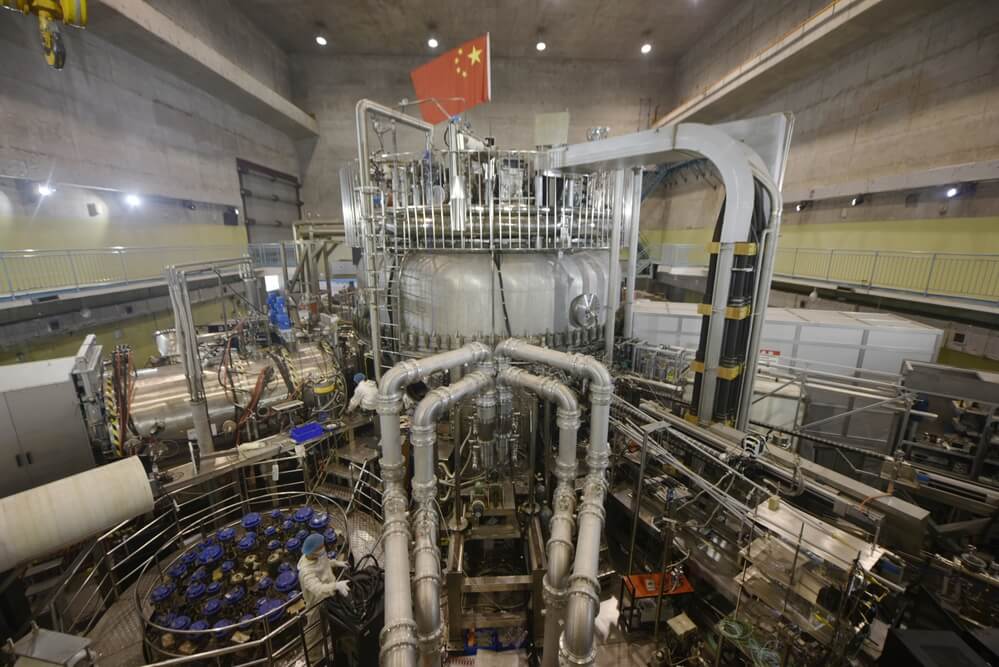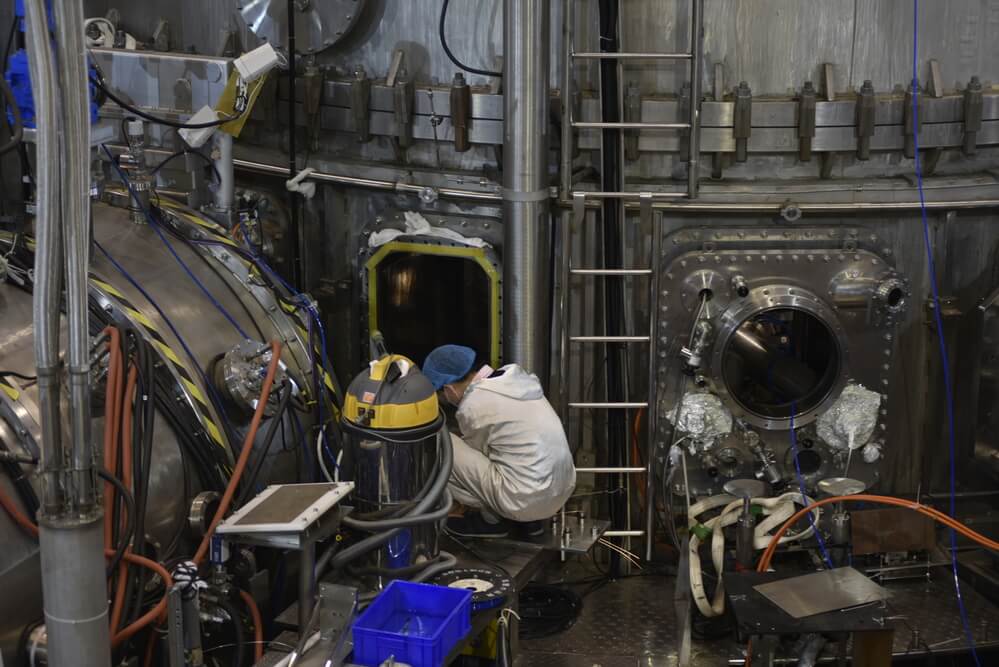35 countries are building the world's largest fusion reactor: why is this needed. PHOTO
The meeting of the heads of the USA and the USSR in 1985 gave the world one of the most ambitious technological projects: the experimental thermonuclear reactor ITER ("path"). In Provence, in the south of France, thousands of scientists and builders are preparing a complex for scientific experiments that could open the way for humanity to the thermonuclear power plants of the future.

ITER thermoreactor under construction in December 2018. Photo: Depositphotos
Thermonuclear fusion excites minds for a long time. In theory, such power plants can be four times more efficient than modern nuclear power plants, while being much cleaner and safer. They have no problems with uncontrolled chain reactions and highly radioactive waste, and seawater can serve as fuel, says Present Tense.
The multibillion-dollar project is being worked on by the EU (46% of expenditures), USA, Russia, India, China, South Korea and Japan (each with 9%). If there are no further delays and problems with financing, then ITER will work already at the end of 2025 - forty years after the talks between Ronald Reagan and Mikhail Gorbachev in Geneva.
The publication tells about the history, present and future of a unique project in the field of thermonuclear fusion.
How it works
Thermonuclear energy is trying to copy the processes that occur inside the stars: there, at ultrahigh temperatures and pressure, the nuclei of hydrogen isotopes merge and release huge energy.
To achieve this on Earth, special conditions are necessary (for example, the temperature is 10 times higher than in the core of the Sun) - they are created in a thermonuclear reactor. It is based, at least, according to the most common scheme that ITER uses - a tokamak, a bagel-like vacuum chamber with magnetic coils. The first tokamaks appeared in the USSR back in the 1960's, for ITER they will build the largest tokamak in the world with a volume of 830 m3.
Deuterium and tritium are launched into a tokamak, and heated to temperatures above 150 million degrees Celsius. The gas turns into a plasma, and so that a plasma of this temperature does not burn everything around, it is kept at a distance from the walls by a magnetic field; a current is passed through the plasma itself. A powerful magnetic field is provided, in turn, by superconducting magnets, which need to be cooled in a vacuum chamber to almost absolute zero - 268 ° C. Physically, they will be literally half a meter from the incandescent to 150 000 000 ° C plasma. Ensuring trouble-free operation of equipment in such conditions is a very difficult engineering task.
Modern tokamaks emit less energy than is spent on heating the system, so far it is not possible to adapt them to generate. The best result is with the British JET, which returns up to 67% of the energy spent. Due to the scale of the ITER design (it will be a huge one about the height of a nine-story building, and about the same diameter), the creators expect that the reactor will be able to emit ten times more energy than is spent on plasma heating (give 500 MW with 50 MW). This moment is crucial for the construction of thermonuclear power plants in the future.
But ITER will not produce electricity: all the allocated energy will be spent only on heating the walls of the tokamak. Although if the experiments with ITER are successful, the next stage (from 2030 of the year) will be the prototype of a thermonuclear reactor for power plants, DEMO - they should appear in the 2040-50's. The desire to build such reactors was announced by India, Russia, South Korea and Japan.
The most important goal of ITER is to demonstrate the possibility of generating energy from a fusion reactor. To do this, it will be necessary to ensure controlled production of “burning plasma” (with it the fusion reaction will be self-sustaining) and achieve self-reproduction of tritium, a fairly rare isotope used as fuel. In addition, ITER should demonstrate how ready modern technologies are for the construction of commercial thermonuclear power plants, and will also allow assessing their reliability and safety.
Safety is one of the key advantages of thermonuclear reactors over conventional nuclear ones. A chain reaction with consequences is impossible here: in case of problems, the plasma instantly cools down and dies out, according to ITER.
The situation with fuel radioactivity is much better: tritium, a weak source of beta radiation, will be generated directly in the reactor. The design of the reactor in this case involves several barriers to the occurrence of radioactive substances during operation. The half-life of radioactive waste for most isotopes in a fusion reactor is about 10 years, while for individual components of spent nuclear fuel, these values can be thousands or even millions of years.
On the subject: A simulation from American scientists: what a nuclear war between the US and Russia will look like. VIDEO
From zero to 63%
At the meeting in Geneva in November 1985, the leaders of the United States and the USSR agreed on a joint study of thermonuclear energy for peaceful purposes - this was the beginning of the project. A year later it was Euroatom, the USSR, the USA and Japan signed an agreement.
Work on the ITER design began in 1988 and continued until the final version was approved in 2001.
In 2003, China and South Korea joined the consortium to work on ITER, and in 2005, India. Then they also chose a place for construction: the neighborhood of Saint-Paul-le-Durance in Provence, France, near the Cadarache Nuclear Energy Research Center.
The interstate agreement on the creation of ITER was signed by the ministers of the 21 member countries on November 2006, and in October 2007, the ITER Organization, the legal entity responsible for the construction, operation and subsequent dismantling of the reactor, began work.
The site began to be prepared back in 2007, and to build in 2010. In parallel, the participating countries began to work on the elements of the ITER complex: India is building a cryostat for the project, the United States is developing a central magnetic coil (it’s enough power to lift the aircraft carrier), the EU and Korea are preparing a vacuum chamber, China and Russia will be supplied with superconductors (100 000 km will be needed such conductors), part of coils and various electrical components, Japan is preparing toroidal field coils.
As of the end of June 2019, the project was “more than 63% ready,” noted the ITER Organization. More than 70% of the buildings have been completed, and the installation of the first components of the reactor itself has begun. The full installation phase should begin next year, as all the necessary components are built and delivered: for example, China built the first 23-ton magnetic coil on September 400, and it will be delivered to the ITER construction site by December.

ITER thermoreactor under construction in December 2018. Photo: Depositphotos
In terms of complexity and manufacturability, ITER is superior to many large-scale scientific construction projects of the century, including the Large Hadron Collider.
“A collider is just a vacuum installation in which a beam of protons is accelerated; this is a task of a simpler level. ITER is plasma physics, and plasma has so many degrees of freedom, so many instabilities, all of them must be dealt with,” Anatoly Krasilnikov, head of the Russian agency of the ITER project, told Radio Liberty. – From the point of view of the large number of parameters that must be taken into account simultaneously, ITER is, of course, a much more complex problem than a collider. Well, ITER is more expensive.”
Such a complex international project based on advanced technologies is really expensive. If at the start the project budget was estimated at € 5 billion, then by 2017 he had already stepped over the mark of € 20 billion: the total figure is difficult to estimate, since governments themselves determine the level of expenses for certain components produced by them. Project participants do not transfer money, but transfer built components. 2020 billion rubles (about $ 22 million) were allocated in the Russian budget for ITER in 11,8-180.
On the subject: Top secret: how an American handed over nuclear secrets to the USSR and did not pay for it
Not just ITER
Bagel-tokamak is not the only option for fusion considered by science. Alternative methods are being studied not only in large government institutions, but also in small startups. There are more than two dozen of them in the world now, according to Bloomberg. However, for the time being, major breakthroughs and controlled energy production on a commercial scale have not yet been discussed.
The closest analogue of a tokamak is a stellarator, also a torus-shaped, “donut-like” system, which, despite all its similarities, does not require maintaining a current in the plasma. Such an installation has its pros and cons; the largest and most successful at the moment is the German Wendelstein 7-X. German researchers set a number of records on it, although in terms of characteristics and scale it is far from ITER.
Startup Commonwealth Fusion Systems, founded by immigrants from MIT, promises to build a much smaller, cheaper, but not much less efficient than ITER, tokamak reactor - SPARC. How will they succeed? Scientists hope to use the latest high-temperature superconductors and are going to show solutions in the next two years.
Another non-standard option is thermonuclear fusion with inertial confinement. It uses lasers that “squeeze” and heat a miniature deuterium fuel capsule from all sides with pulses, simulating the processes that occur during the explosion of a hydrogen bomb. The world's largest scientific organization using this approach is the National Ignition Facility in the USA, where 193 beams of powerful lasers are used for these purposes.

ITER thermoreactor under construction in December 2018. Photo: Depositphotos
Why and when?
Critics believe that thermonuclear fusion is too expensive and commercially ineffective, and they call for investment, for example, in renewable energy. ITER does not deny its importance, but emphasizes that the creation of new clean energy sources with a constant level of generation (not dependent on, say, the number of sunny days or wind strength) remains an important task. Thermonuclear energy will not replace renewable energy, but together with it it will serve as an even better alternative to traditional “dirty” energy sources, according to ITER.
The only question is when this will happen. The first launch is planned for December 2025 (“the best technically achievable date”) using hydrogen, then helium, deuterium will be added, and finally full-fledged operation on deuterium-tritium is planned in 2035: only then will it be possible to achieve a tenfold power output. The project's completion dates have already been pushed back, and given its complexity, it is unlikely that further delays will not occur. In addition, despite all attempts, at the current stage of technology development, thermonuclear fusion may turn out to be too expensive for industrial use.
Skeptics sarcastically say that “fusion is the source of energy of the future, and will always remain so.” In just a few years, humanity will be able to cool down the ardor of skeptics or once again strengthen their positions.
Given the complexity of the topic, it is unlikely that anyone is ready to guarantee deadlines in such projects. One of the pioneers of the industry, Soviet academician Lev Artsimovich, when asked when thermonuclear energy will appear, answered simply: “When it becomes really necessary for humanity.”
Read also on ForumDaily:
Mankind threatens mass extinction: people turned out to be the largest disaster for the Earth
The series 'Chernobyl' was the triumph of the Emmy Award. VIDEO
The most mysterious secret base in the United States: what really happens there
Subscribe to ForumDaily on Google NewsDo you want more important and interesting news about life in the USA and immigration to America? — support us donate! Also subscribe to our page Facebook. Select the “Priority in display” option and read us first. Also, don't forget to subscribe to our РєР ° РЅР ° Р »РІ Telegram and Instagram- there is a lot of interesting things there. And join thousands of readers ForumDaily New York — there you will find a lot of interesting and positive information about life in the metropolis.











